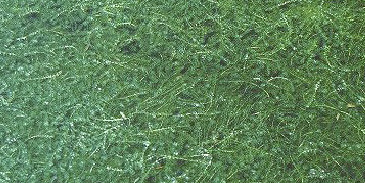|
|
|
| • • |
|
Hydrilla |
|
(From the Nature Conservancy) Hydrilla verticillata is a submerged aquatic plant with heavily branched stems that grow towards the water's surface. It is characterized by its long, slender stems that can grow as tall as 30 feet and are heavily branched. The leaves are long, whorled, and bear small conical bumps on its underside. The partial evergreen will occasionally produce small white flowers as well. Usually rooted, hydrilla can also be found floating around a body of water in a large mass. Native to Asia, Africa and Australia it is considered an invasive species in the United State.
Hydrilla's presence in the United States is one of irritation as we consider it one of the "most unwanted" species in our bodies of water. The reason for our aggravation comes from the fact that hydrilla, like Godzilla terrorizing Tokyo, leaves lakes, rivers and other waterways up heaved and terrorized. The invasive specie forms a dense canopy that forces native species to compete for nutrients and blocks much needed sunlight to aquatic plants below, basically pushing out our native aquatic species out of their home. Aquatic animals are also affected in heavily infested waters. Fish population imbalances are likely when over abundant amounts of hydrilla is present. The dense mats raise the water's pH, oxygen levels fluctuate and water temperature rises. The fish are left smaller in size and weight; sportfish populations greatly decline. |
